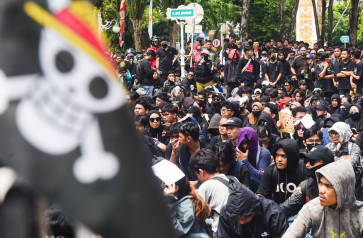Popular Reads
Top Results
Can't find what you're looking for?
View all search resultsPopular Reads
Top Results
Can't find what you're looking for?
View all search resultsStories within dances
Through the graceful combination of movement, music and colorful costumes, every Balinese dance tells a fascinating story about humanity and wisdom that is probably rarely heard today
Change text size
Gift Premium Articles
to Anyone
T
/span>Through the graceful combination of movement, music and colorful costumes, every Balinese dance tells a fascinating story about humanity and wisdom that is probably rarely heard today.
Charming, colorful and magical are probably not good enough words to describe Balinese dance, an exquisite art that has made the country and Bali renowned throughout the world.
The dances captivate many of us and attract people from all over the world to watch and try to get a deep understanding of the story and philosophy within each dance.
Kartika D. Suardana lists 21 stories behind Balinese dances in her debut book, Dances of Bali, which features beautiful photos of dances from all over Bali.
The book is actually a compilation of articles about Balinese dance that were published at NOW! Bali magazine, where she served as an editor.
When the magazine was about to be published for the first time, she came up with idea to start it with a dance story.
Two years later, the stories were compiled and reedited to keep them timeless so they could be shared with readers who had not followed the series in the magazine.
In the introduction, she writes that the most important thing that is needed to enjoy traditional Balinese dances is to know the stories told by the dance routines.
Balinese dancers are known to take dance seriously. Before dancing, they pray so the gods can give a blessing to their performance in order to achieve taksu, a compilation of perfect dancing technique and charisma that they hope can mesmerize the audience.
For the Balinese people, dances are part of their religious rituals and are often performed at ceremonies or cultural events. The dances are dedicated to welcome deities and ancestors visiting their ceremonies and to show their gratitude to gods for the blessing.
Just like the magazine, the book is opened with two welcoming dances, the Panyembrama and Puspanjali. Panyembrama, which also means “welcome”, is a creation of I Wayan Berata and was first performed at the Pandan Festival in 1971.
He created this dance by combining some basic Balinese dances such as legong keraton and condong.
Meanwhile, the Puspanjali dance was created by Swasthi Widjaya Bandem and I Nyoman Windha and was performed by seven dancers to welcome the visitors through dynamic movements inspired by the rejang dance, one of the most sacred dances in Bali, honoring the visitors with flower as a symbol of a beautiful heart and goodness.
The dance stories in the book are classified into two sections, ancient and sacred, and describes legendary traditional dances that are still performed until now; and fresh and authentic, which discusses modern Balinese Dances.
The ancient and sacred section consists of descriptions of some legendary dances including rejang, baris, pendet, the trance dance, calon arang, legong, the mask dance and kecak. Some of those dances are performed for commercial purposes such as entertaining tourists while others can only be performed during holy ceremonies in the temple.
Rejang, for example, is performed during particular holy ceremonies in temples in Bali. Only virgins and mothers or women over the age of 60 are allowed to perform this dance. There are many types of rejang dances that are performed differently in each temple across the island.
In Tenganan village in Candidasa, rejang is divided into four parts with dancers wearing authentic handwoven ikat tenganan pageringsingan fabric with gold flower ornaments on their heads; while in Besakih, girls wear head accessories made from dried palm leaves and brightly colored fabric with golden flower patterns.
Dewi, as Kartika is known, shares her interest in dance by providing light and easy explanations about the myths and stories behind each dance. Not only that, she also tells of her own experience and childhood memories about certain dances.
In the sacred and ancient section, Dewi recalls watching the Calon Arang at Pura Dalem when she was still a little child.
Calon Arang is a sacred dance that tells the story about the victory of dharma (virtue) over adharma (vice). The dance tells the story of a widowed witch named Calon Arang in Girah who always spreads disease and pestilence around the village because nobody wants to marry her daughter.
King Erlangga appoints Mpu Baradah to kill the widow. Mpu Baradah then asked his son to marry the witch’s daughter while he himself fought the evil witch.
One of the amazing things in Balinese dance is that sometimes the dancers seem to enter into a trance and hurt themselves by stabbing themselves with kris. This happens in Calon Arang; during the Ngelawang, the opening ceremony of the Mekare Kare festival in Tenganan; and the Shangyang dance. The dancers have to perform a certain ritual to go into a trance, although in some dances, such as in Calon Arang, the preparation is not necessary.
The other half of the book tells of modern dances that were created by Bali’s most talented maestros.
In this book, Dewi includes dance creations such as the Candra Metu, a dance which is almost extinct, created by Bali’s noted dancer Jero Puspawati, who has been dancing since 1933; the Teruna Jaya by Pan Wandres; the Wiranata and Panji Semirang by legendary maestro I Nyoman Kaler; the Kebyar Duduk by I Ketut Maria; and the Satya Brastha by I Nyoman Cerita.
Besides the heroic stories, traditional Balinese dances also inspire us with fables. Manuk Rawa is a creation of I Wayan Dibya that delights the eyes with its colorful costumes and pleases the ear with melodies that Dewi says could bring her into a live presentation of bird habitat on mangroves.
An epic story is also presented through the frog dance, where we can learn a lot about karma and reincarnation of Jenggala, who was reborn as a frog.
Dances of Bali is colorful for readers to enjoy but since it’s not a guidebook, you might not find a guidance about where and when you can watch a specific dance.
Dewi, however, explicitly mentions locations in some of the stories so you know where you have to go if you want to watch it, like at some regular cultural events.
During the book launch at the end of August, she also put framed dancing photos up for auction. The money raised from the auction went to the Sanggar Tari Warini dance school run by Arini, one of Bali’s dance living legends, to support dance education and activities.
Dances of Bali
Kartika D. Suardana
NOW! Bali Publications, 2012
121 pages










